Phoenix was packed last Saturday — or maybe it wasn’t. The 29-person cooperative house navigates more like a labyrinth, so it was hard to tell if there were a lot of people or if the house was playing tricks on me.
There were two cops outside handing someone an infraction when I arrived, which was around 10 p.m., about an hour after the party started. Someone began telling people gathered outside that they either "needed to go inside or leave" due to the noise, and most people followed. By the time I left hours later, the lawn was refilled with people — maybe even more than earlier.
The basement was warm enough to forget how cold it was outside. It's a different feeling to step into that kind of party. The music was live, hard rock that eventually faded into the back of my mind the longer I stayed. The performers were illuminated by LED lights, the main light sources for the entire room. I could see what was directly in front of me, just not enough to pick anyone out of a crowd if I wanted to — a task I found myself attempting to do while looking for Daniel, my photographer.
The walls (and not just the ones in the basement as I later came to find out) were marked with hand-painted designs depicting abstract faces and curvilinear shapes that seemed vaguely reminiscent of an acid-fueled Beatles movie. It was a perfect venue for the event, so much so that I asked myself, do people really live here?
This isn’t the scene most people think of when imagining a Michigan State University student’s weekend. Weekend nights are for long lines outside The Riv or house parties. However, the mention of a typical college party brings an image to mind, a mood even. One not dissimilar to this:

The funnel. The drops of beer. The boisterous men on the rooftop encouraging it all. The congregation of fresh adults, some of whom are breathing their first breath of freedom, requires no order. There is as much of an art to these parties as there is to a Coors Light. This is and has been the college party, and many have not needed much more.
The college party has become synonymous with "The Frat Party" which, in turn, has evolved into something other than simply a party thrown by fraternity members. Because if we take those parties and remove the kegs and what seems like the same songs being played over and over again, there exists a goal of these parties that is understood by most in attendance but rarely discussed formally.
It’s the same goal that creates an unwritten list directing women to steer clear of certain frats, designating one the title of being safe and another not. It’s guided by conservative values that tell certain young men that their surroundings are something that should be controlled and hegemonized according to what they want. The Frat Party then, in this inception, is only welcoming, or safe, for a select group of people.
It’s no secret where the need for control leads. People get hurt, people get assaulted, people get killed. At best, those whose clothing, body types, gender or sexual orientation don’t fit the bill are kicked to the curb.
And yet, college students finding a place to party on the weekends is inevitable. If history tells us anything, it’s that if people are rejected from one space, they’re just going to find another.
That space, branching off from the late nights of Grand River, more often than not ends up being found in cooperative housing: the necessary alternative to the fraternity and sorority. Co-ops (as they’re shortened to) aren’t explicitly founded on the basis of being an alternative to Greek life, but the established purpose of explicitly not discriminating based on identity almost forces the community into an antithetical role.
There are 17 co-ops listed on the Spartan Housing Cooperative website, each with its own name (some named after the likes of David Bowie and Miles Davis). They’re affordable by design. Not all of them throw parties.
But when they do, it’s an event.
Phoenix had a couple bands play when I visited — most of them being some kind of rock or punk, which was in line with the ‘cute punk’ theme for Valentine’s Day. Punk isn’t a style I’ve ever gotten into, but after some experimentation, I was eventually content with what I threw together: a leather jacket layered with a zip-up hoodie, black pants, and some silver jewelry. I was proud of the outfit, but part of going to co-op parties is accepting that someone there will interpret the theme better than you did and put together a better outfit because of it.
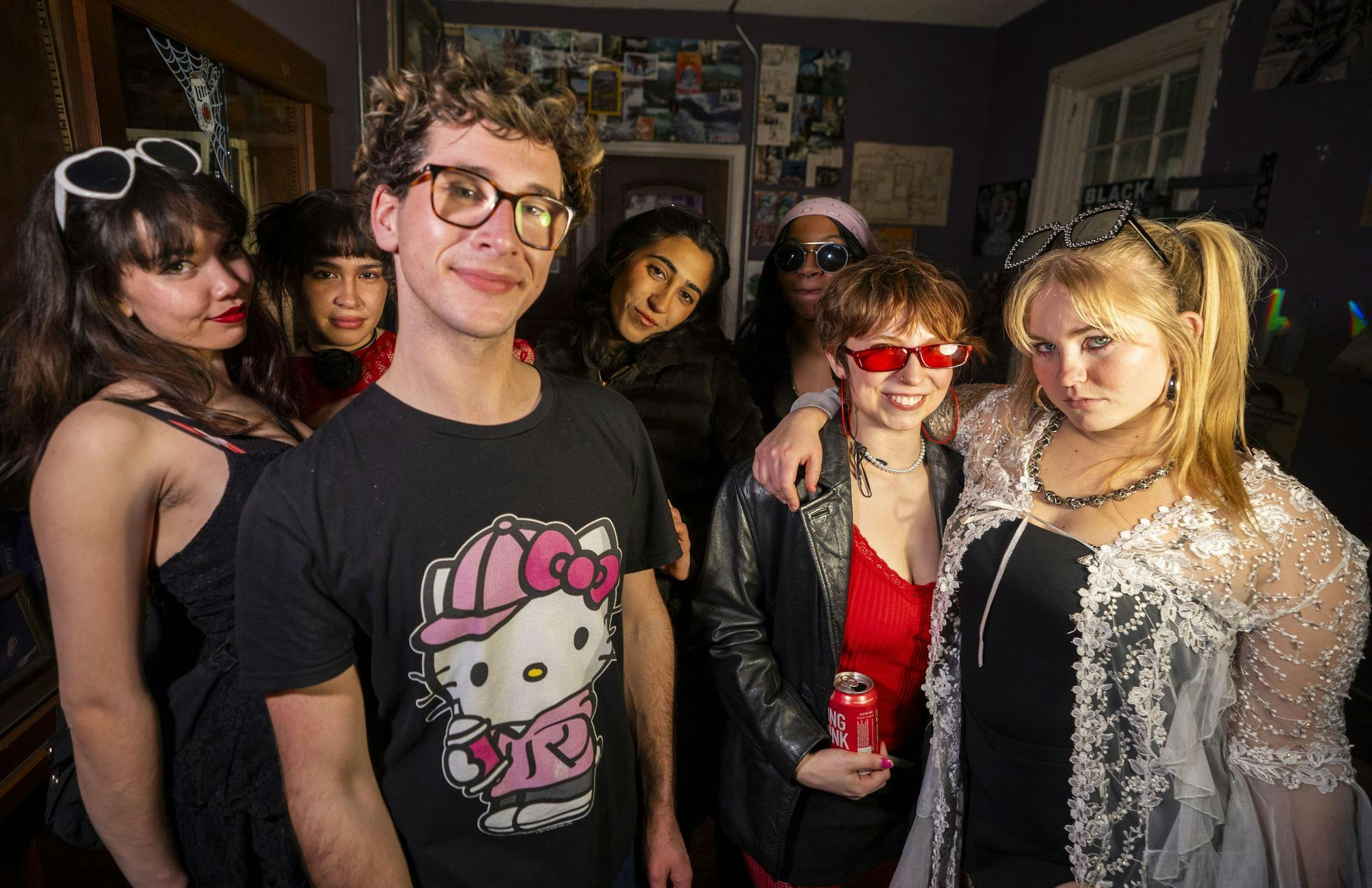
Partygoers pose for a portrait at Phoenix House Cooperative in East Lansing, Michigan during their Valentine's Day party on Feb. 15, 2025. The group said they have been frequenting cooperative parties for over two years.
The reason being that people plan ahead. Not just the people in attendance, but the people running the show. Before the party, I talked to AJ Schicht, a fourth-year at Michigan State University and the vice president of membership for the Spartan Housing Cooperative. He told me that during the morning before a party, the students set up in accordance with details decided weeks or perhaps even months ago. And almost like clockwork, each member of the 20-something person cooperative housing unit is assigned a chore that they are held to for the hours leading up to, during, and after the party.
Chores look different depending on the party. Soundproofing rooms so a techno artist may be able to perform in the basement without impeding on the Midwest emo band upstairs, assigning members to clean up the after-party mess and having people at the door to let people in are common job assignments. It’s a system co-opers draw from their day-to-day lives.
AJ lives in Vesta and is often involved in the more bureaucratic aspects of party planning, which involve theme-setting, finding musicians, settling on a date and designating rooms for people to be in.
Because co-ops are, at their core, made of people entering into a financial and moral agreement, I find that there’s a strong sense of kinship in these houses. Even if not everyone completely knows or talks to each other all that much, they always have the house to maintain, a common goal to keep in mind.
Support student media! Please consider donating to The State News and help fund the future of journalism.
While I was talking to AJ over the phone, he at one point had to shush a slowly-building congregation of lively housemates, "I love you all, but can y’all go somewhere else?" he said. The sentiment is reflected in the party: "If someone is not feeling well, if someone's sick, we're taking care of them."
Leda Celeste, a 21-year-old living in Bower, was exposed to co-op culture earlier than most. She entered the co-op scene when she was about 8 years old, living in Shire with her parents. She moved around a fair bit but stayed in co-ops for affordability. "It’s been a consistent option for me," she said.
The parties were consistent, too, which is something she’s enjoyed over the years. She sees the party as an outlet for creativity, a way for artists to let their creative juices flow. Because for performers, this might be the only space to do that before they enter their adult lives.
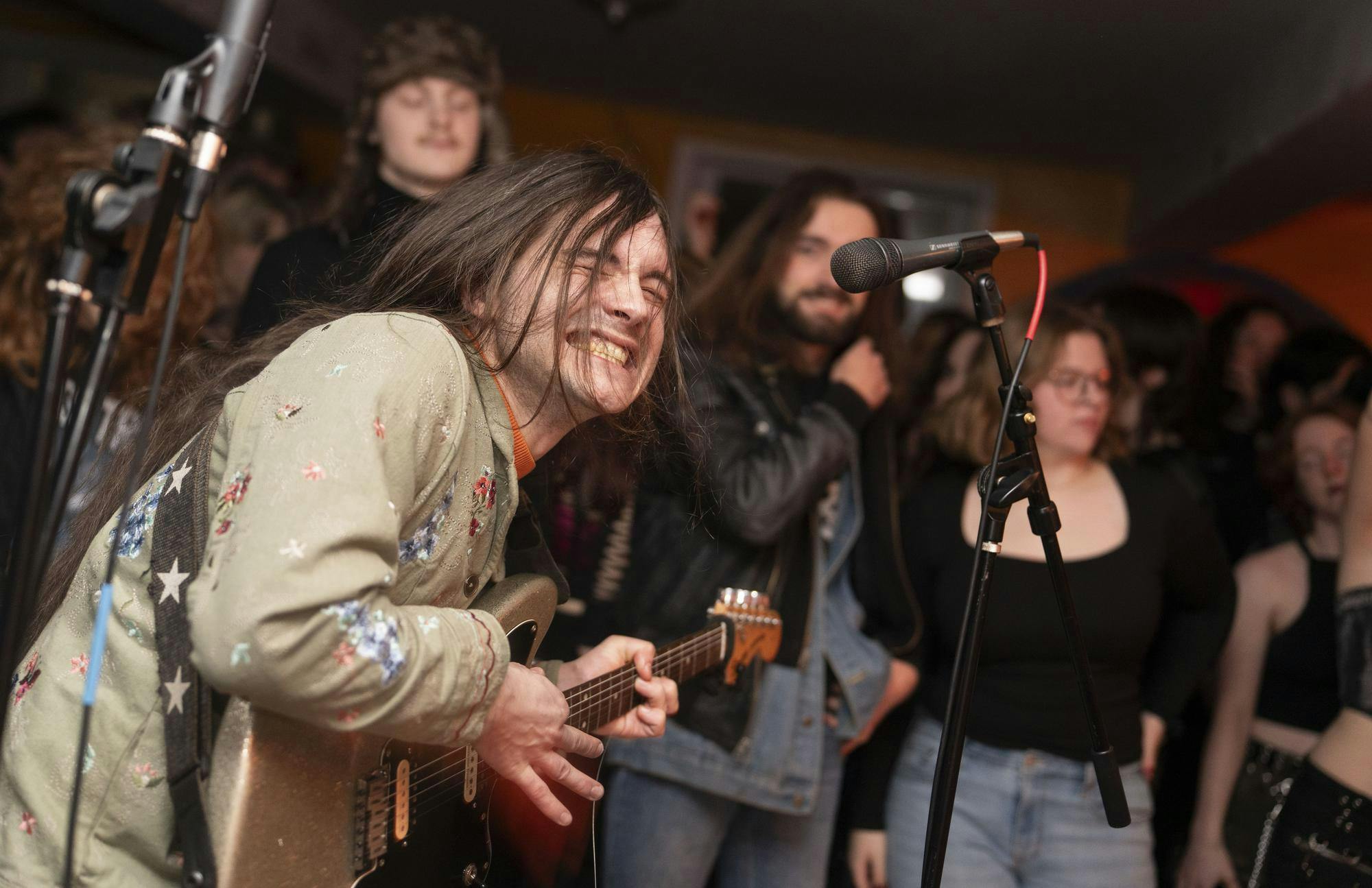
Harper McNamara, guitarist of Grassland Reptiles, plays for a crowd at Phoenix House Cooperative in East Lansing, Michigan during their Valentine's Day party on Feb. 15, 2025.
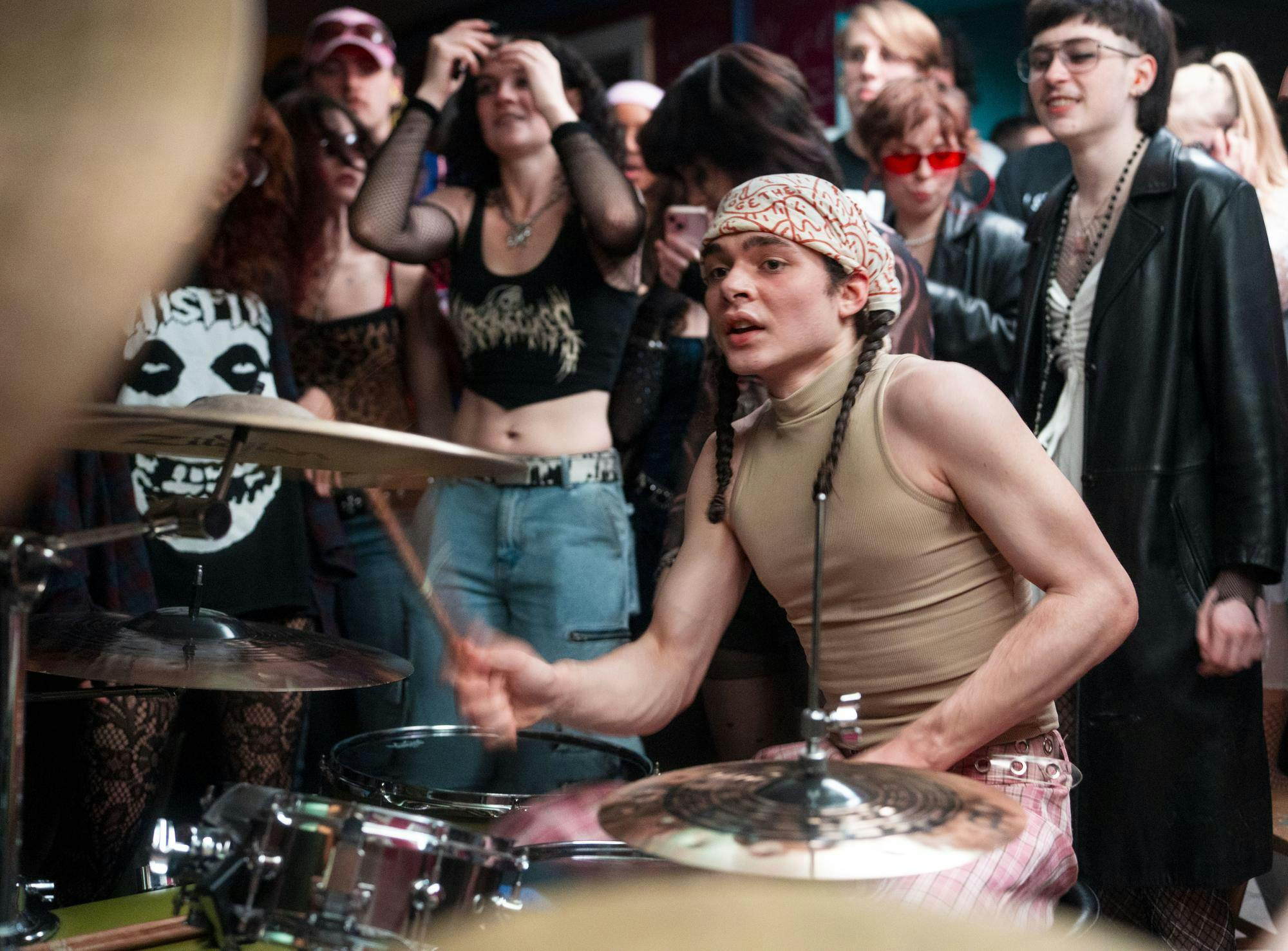
MacKenzie Alexander, drummer of Grassland Reptiles, plays for a crowd at Phoenix House Cooperative in East Lansing, Michigan during their Valentine's Day party on Feb. 15, 2025.
Across the multiple co-ops she’s bounced between, she’s also seen a space for communities to connect, most notably queer communities. It removes expectations typically placed on people in other spaces. There’s no one way to dress, express, or be.
I’ve also noticed co-opers quite simply care about the safety of their membership and those in attendance. Houses generally have Narcan and participate in sexual assault prevention training. In Phoenix's upstairs bathroom, there’s a placard that reads "Phoenix Haus Consent" and lists the four Cs of consent: clear, continuous, coercion-free and conscious.
I don’t actually know how effective such a reminder is — I don’t have data on hand for that sort of thing, and I never asked for it. And it’s not to say that co-ops and their parties are utopian. But I do know I’d never find a sign like that at most other house parties.
The co-op philosophy then creates a space meant for enjoyment, something that seems so simple when I think about how far we’ve collectively strayed from the mission of the party. It’s a space where, for a few hours, a multi-storied house can become a world independent from the world outside the window, one where each occupant has agreed to bring in only what they want. They’re not pretending to be something they’re not; they’re just letting out parts of themselves that lie dormant throughout the rest of the week.
What is the goal of a party if not that?
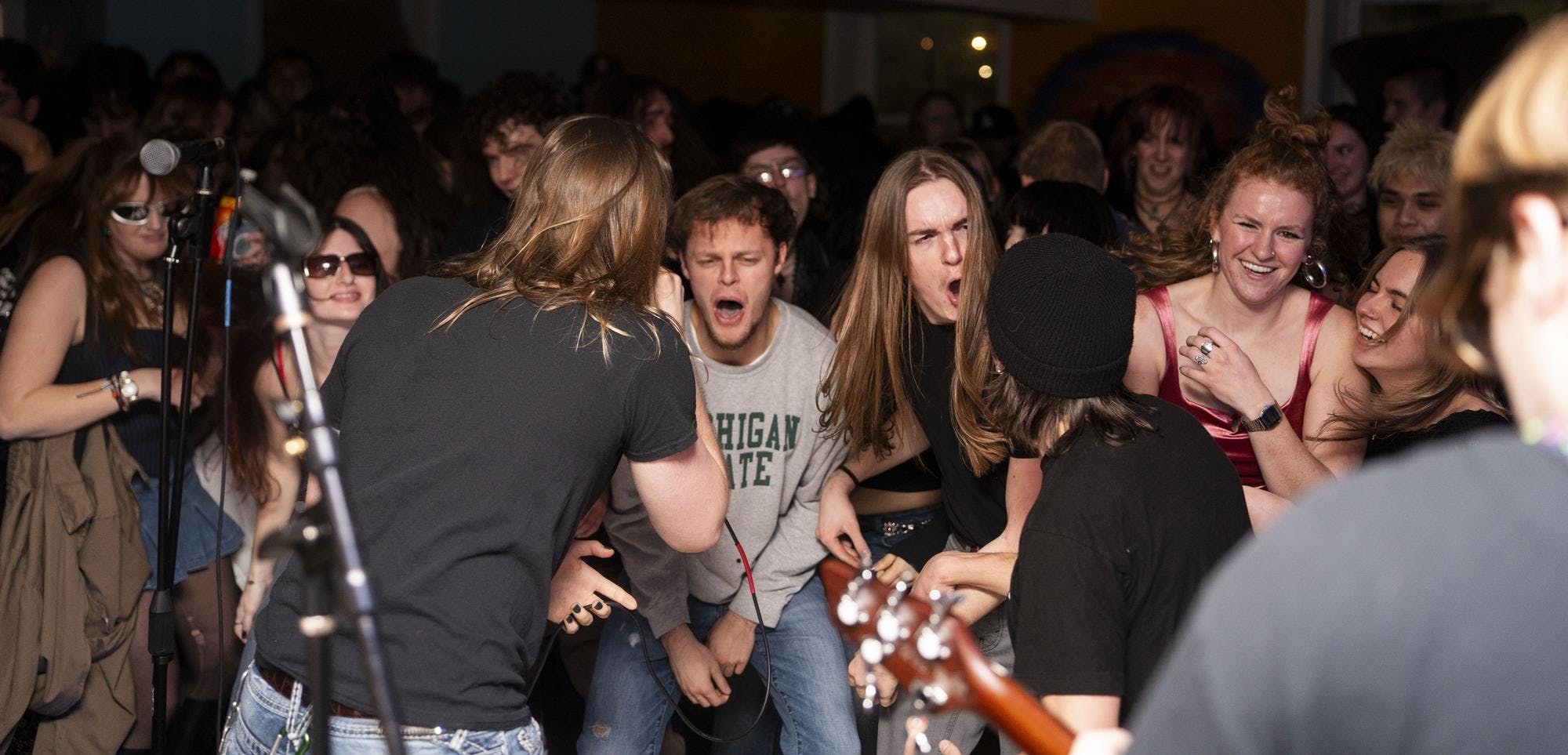
Guests shout along with Faceless, a band performing at Phoenix House Cooperative in East Lansing, Michigan during their Valentine's Day party on Feb. 15, 2025.
Zach Oliver, a student and musician, called it social reprieve. His friend Sameer Saraswat, a techno artist, called it an outlet; there’s more to it than just Dionysian indulgence, he said. People get wound up during the week, and the party can and should serve these functions. The idea has been echoed to me by various DJs and people who attend.
But the essentiality of such a reprieve is, maybe unsurprisingly, found in the music. The idea of starting a music booking company was thus on Zach’s mind for some time before he started The Cadre with Sameer and his other friend James Connor Ziadeh, who goes by Connor.
The Midwest emo scene, more specifically booking companies, wasn’t new for them with the presence of spaces like The Goblin Zone, a house-booking show run out of Lansing. The Cadre was initially on track to become something similar, but Sameer was more drawn toward electronic music.
"I’ve always liked guitar music," he said to me in conversation with Zach and Connor at Haraz Coffee House a few weeks ago. "But you can’t dance to it."
Electronic music, on the other hand, is almost made with the intent to get people to move. It's music created directly in front of its audience — it's a lot more personal, says Sameer. Yet as much as he wanted to book shows on top of creating music, he admitted that he didn’t have it in him to do all the bureaucratic stuff. Zach did.
The Cadre, then, came into fruition in August 2024, primarily utilizing co-ops as spaces for them to put on music, something that works well when considering the popularity of dance and techno music in the co-op scene. For Zach, however, there was a deeper goal beyond music and dancing, one he kept returning to when we spoke.
The three of them were no strangers to the reputation "The Frat Party" has developed — exclusionary and unsafe. So, Zach set out to make The Cadre as accessible as possible. And much like the co-ops, the mission was not to be the antithesis of frat parties, but the very nature of being more accepting brings the conversation back to it. Zach acknowledged that the perception of frat parties isn’t all-encompassing, but it’s enough.
It's a hard thing; I’ve been to frat parties where the men are kind and there’s a welcoming atmosphere. I’ve also been to frat parties where I’ve overheard people say, "don’t worry about him, he’s gay." I’ve also been to frat parties where men get overly aggressive with women on the front lawn while their brothers watch with indifference.
It’s a headache to worry about how one might be treated just as much as it’s a headache to keep a mental list of which ones are "safe" to go to and which ones aren’t.
The mission for Zach is to ascertain people as being safe and let them in if they are.
Inside parties put on by The Cadre — if they can even be called that since Zach likes to set them up as concerts out of respect for the artists (although even he can’t fool himself that the events are treated like parties by those in attendance) — the three try to emulate a rave. They’re good at it too. People are packed together but still with enough room to move their bodies without disrupting the people next to them, and the music certainly supplements that experience. They follow the PLUR mantra, an acronym popular in the techno/rave community which stands for peace, love, unity and respect. But it’s not something that’s just repeated to the point of exhaustion; it’s an atmosphere, a feeling.
If there’s no PLUR at your party, you’re simply not doing it right.
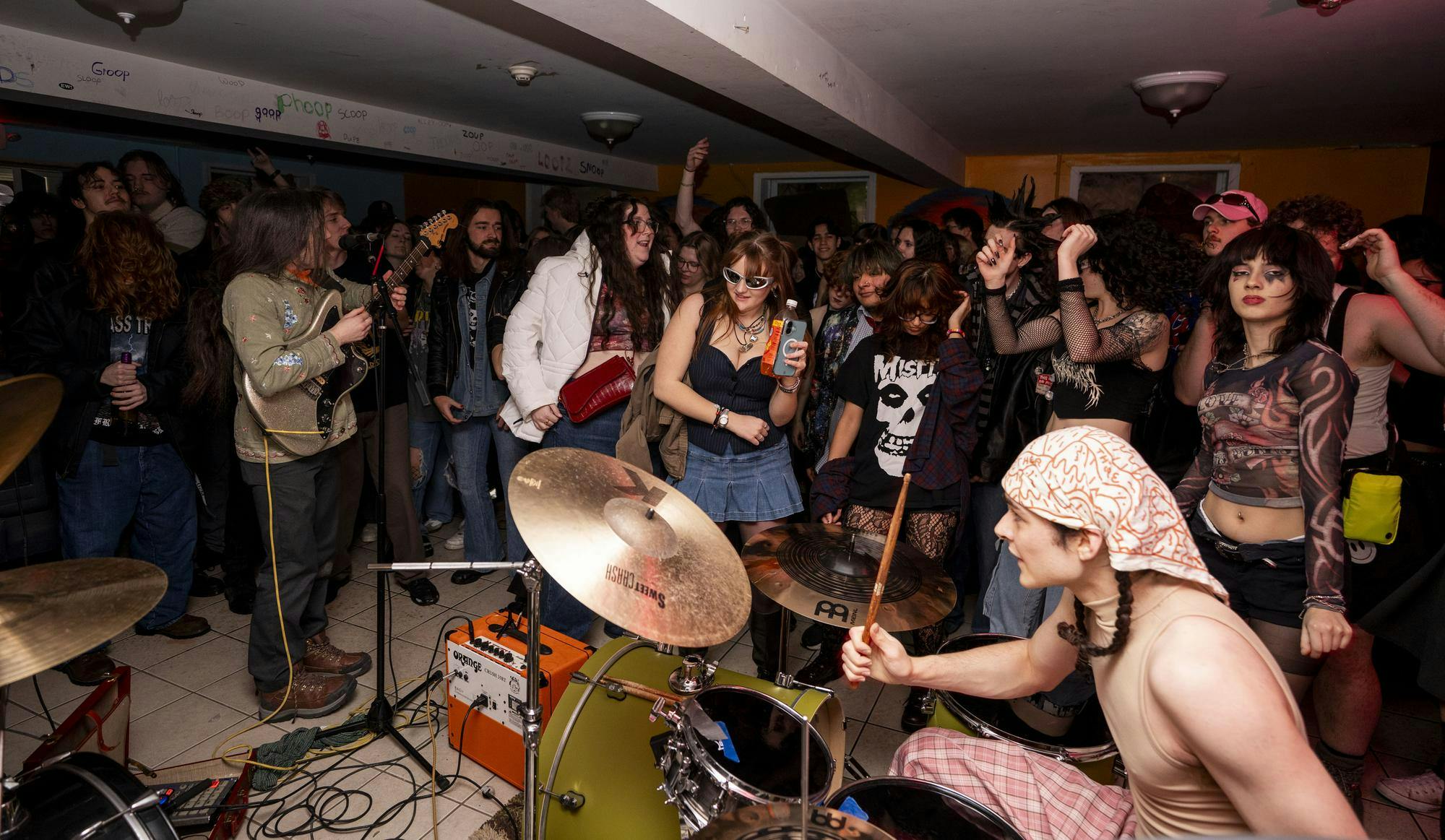
Grassland Reptiles guitarist Harper McNamara and drummer MacKenzie Alexander jam for a crowd of about 100 at Phoenix House Cooperative during their Valentine's Day party on Feb. 15, 2025.
And contrary to popular portrayal, raves aren’t filled to the brim with drug-fueled hedonists. AJ put it in a similar vein: people in co-ops aren’t "all Earth-praising hippies," which isn’t to say that the co-op life isn’t at least vaguely reminiscent of the collectivism found in the youth counterculture movement of the 1960s (at one point one of the performers at Phoenix quieted the crowd to make sure we knew that "we’re all flesh and blood, we’re of the same people"). There’s a focus on togetherness that simply isn’t found at every party.
Electronic music isn’t without its physical effects either. It’s meant to move people, make them dance or otherwise feel like they’re on drugs. There’s an escapism to it, a way for students to get away from sometimes harsh realities, a DJ named Corey Mann told me.
Corey (Fat Jimmy when he’s performing) plays electronic music predominantly at co-op parties when he’s not studying neuroscience during the week. Like the others, he sees music as one of the focal points of a good party, once again positing the party in this conception as being opposed to "The Frat Party" with their, as he said, "top 40 music," music that is often admitted by frat men themselves as being awful. But hey, if the party isn’t about the music, then who cares if it’s awful?

Trent Cramer, drummer of Faceless, plays for a crowd at Phoenix House Cooperative in East Lansing, Michigan during their Valentine's Day party on Feb. 15, 2025.
If music is one half of the artistic pursuits found at the co-op party, then fashion is the other. There’s something special about loads of people all agreeing to dress according to theme. Corey, estimating 50% of the crowds at co-op parties are part of the LGBTQ+ community, said that their distinctive taste in the arts is what makes it great.
Since going to Phoenix, I’ve been thinking about something Sameer said: "The art of the party is getting people to be the most human they can be, to feel the most connected to other people that you can be. We're inviting people to be vulnerable, to look silly, to do a dumb dance move, and then to look around and see that everyone else is doing the same dumb dance move, because the track is f—— crazy."
There's art found in the music, as much as there is in the fashion, as much as there is in the practicalities of organizing such events. As complicated as it is, the night ends with me walking home under the familiar lights of Grand River Avenue, dressed like a punk out of the '70s. I looked like a caveman that slipped through time, frantically looking for some type of pleasure that doesn’t exist anymore.
When I made it home, the eyeliner I had applied to my upper waterline was smudged around my eyes. I did a quick, lazy wipe and went to bed. My experience then only culminates in the night fading into a blur of bright primary colors and noise as time passes. I struggle to even make out the faces of the people I met lest I be reminded by a stranger’s passing glance on my way to class weeks later.



